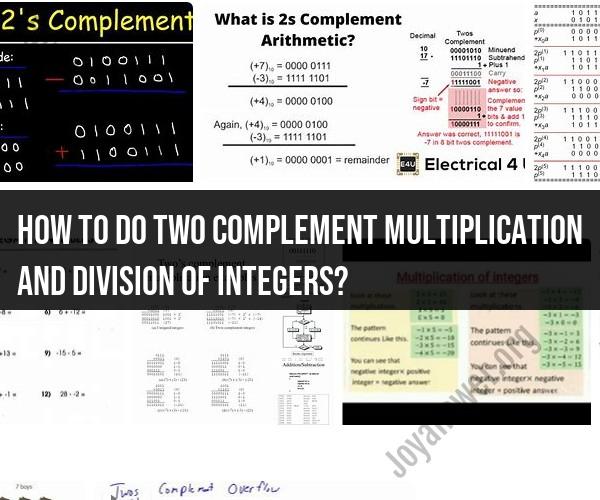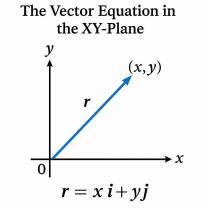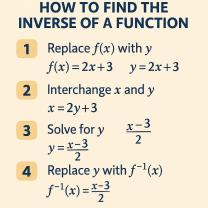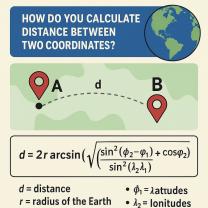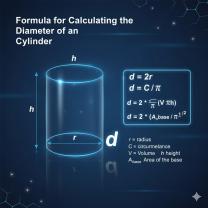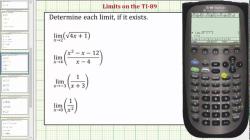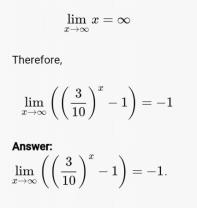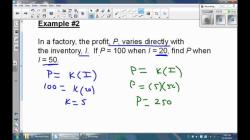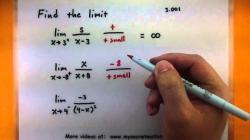How to do two complement multiplication and division of integers?
Two's complement multiplication and division of integers are mathematical operations used in computer architecture and digital arithmetic to perform multiplication and division of signed integers represented in two's complement notation. Here's how these operations are typically carried out:
Two's Complement Multiplication:
Convert the Multiplicands to Binary: First, convert the two signed integers (multiplicands) you want to multiply into their two's complement binary representations.
Multiply as Unsigned Integers: Perform binary multiplication as if the numbers were unsigned. Use standard binary multiplication techniques like long multiplication. Ignore the signs for now.
Determine the Sign of the Result: After multiplying the numbers as if they were unsigned, you'll get a binary product. The leftmost (most significant) bit of the product indicates the sign of the result. If it's 0, the result is positive; if it's 1, the result is negative (in two's complement form).
Convert the Result to Decimal: If the result is negative (the leftmost bit is 1), take the two's complement of the product to get the correct negative value. If it's positive (the leftmost bit is 0), convert the binary product to decimal.
Two's Complement Division:
Convert the Dividend and Divisor to Binary: Convert both the dividend (the number being divided) and the divisor (the number you're dividing by) into their two's complement binary representations.
Perform Division as Unsigned Integers: Perform binary division as if the numbers were unsigned. Use standard binary division techniques like long division. Ignore the signs for now.
Determine the Sign of the Result: After dividing the numbers as if they were unsigned, you'll get a binary quotient. The leftmost (most significant) bit of the quotient indicates the sign of the result. If it's 0, the result is positive; if it's 1, the result is negative (in two's complement form).
Convert the Result to Decimal: If the result is negative (the leftmost bit is 1), take the two's complement of the quotient to get the correct negative value. If it's positive (the leftmost bit is 0), convert the binary quotient to decimal.
It's important to note that in both multiplication and division, the sign bit (the leftmost bit) is critical for determining the sign of the result in two's complement notation. Additionally, overflow conditions may occur in both operations when the result exceeds the representational capacity of the allotted bits, so careful consideration of the number of bits used is essential to avoid errors.
Mastering Two's Complement Multiplication of Integers
Two's complement multiplication is a method of multiplying integers that is commonly used in computers. It is based on the two's complement representation of integers, which is a way of representing integers in binary form.
To perform two's complement multiplication, we first need to convert the two integers to be multiplied to two's complement representation. Once the integers have been converted, we can multiply them using the following steps:
- Multiply the two integers in the same way that you would multiply two binary numbers.
- If the product is less than 32 bits wide, then we are done.
- If the product is greater than 32 bits wide, then we need to perform sign extension. Sign extension involves copying the most significant bit of the product to all of the empty bits on the left side of the product.
- Finally, we need to truncate the product to 32 bits. This involves discarding the most significant bit of the product.
Division of Integers Using the Two's Complement Method
Two's complement division is a method of dividing integers that is commonly used in computers. It is based on the two's complement representation of integers, which is a way of representing integers in binary form.
To perform two's complement division, we first need to convert the dividend and divisor to two's complement representation. Once the dividend and divisor have been converted, we can divide them using the following steps:
- Divide the dividend by the divisor in the same way that you would divide two binary numbers.
- If the remainder is less than 16 bits wide, then we are done.
- If the remainder is greater than 16 bits wide, then we need to perform sign extension. Sign extension involves copying the most significant bit of the remainder to all of the empty bits on the left side of the remainder.
- Finally, we need to truncate the remainder to 16 bits. This involves discarding the most significant bit of the remainder.
Exploring Arithmetic with Two's Complement Representation
Two's complement representation is a powerful way to represent integers in binary form. It allows us to perform arithmetic operations such as addition, subtraction, multiplication, and division in a simple and efficient way.
Two's complement representation is also used in many other areas of computer science, such as floating-point arithmetic and cryptography.
Conclusion
Two's complement representation is a fundamental concept in computer science. It is used in a wide variety of applications, including arithmetic operations, floating-point arithmetic, and cryptography.
By understanding two's complement representation, we can gain insights into the way that computers work and develop more efficient and reliable algorithms.
